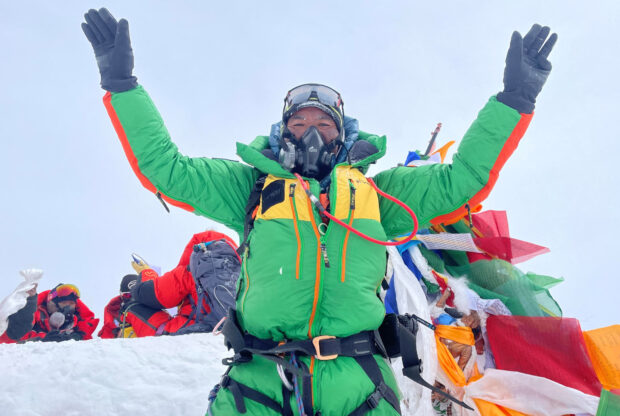From highs to lows, Everest record breaker sees ‘no future’ in Nepal

Kami Rita Sherpa, 53, a Nepali Mountaineer who climbed Mount Everest for a record 28 times, is pictured on the summit of Mount Everest during his 28th summit in Everest, May 23, 2023. Kami Rita Sherpa/Handout via REUTERS
KATHMANDU — Kami Rita Sherpa had stood at the top of world just days earlier, exultant at having summited Mount Everest for a record 28th time.
The Nepali climber was given a hero’s welcome on his return to Kathmandu, but all that joy appeared to have deserted him as he surveyed life’s highs and lows from an armchair in the small, neat living room of his rented apartment, while his wife poured tea.
“There is no future in Nepal,” the 53-year-old father of two told Reuters over the weekend.
“Why stay here?” he asked, speaking in his native Nepali and a smattering of broken English. “We need a future for ourselves… for our children.”
Wearing a baseball cap bearing the legend “Everest Man”, and his face blackened by wind and snow burns, Kami Rita is clearly proud of his achievements. But he is also grateful that money he made as a guide with mountain expeditions helped him move to Nepal’s capital so that his children could have the education he never received.
Article continues after this advertisementHis son, 24, is studying tourism and his daughter, 22, is doing an Information Technology course.
Article continues after this advertisement“This would not have been possible had I continued to stay at Thame and not taken to climbing,” said Kami Rita, who left school in his mountain village when he was around 12 years old.
Awards and Guinness World Record certificates fill the showcase behind him, and posters of Kami Rita on Mount Everest adorn the walls, but he talked of immigrating to the United States to find new opportunities for his family.
Kami Rita was born in the same Himalayan village as Tenzing Norgay, the sherpa who together with New Zealander Sir Edmund Hillary made the first summit of Mount Everest 70 years ago.
The village of Thame is in Solukhumbu, a district that has become a Mecca for mountaineers since that first successful ascent on May 29, 1953.
Located on the border with China’s Tibet, Solukhumbu’s crowning glory is Mount Everest, the world’s highest peak at 8,849 meters (29,032 feet), but it also hosts Lhotse (8,516 meters), Malaku (8,481 metres), Cho Oyu (8,201 meters), Gyachung Kang (7,952 meters) and Nuptse (7,855 meters) – all names that any top mountaineer would want on his CV.
Sherpas, an ethnic group living in the Everest region, have always been the backbone of mountain expeditions. They fix ropes, ladders, carry loads and also cook, making anything between $2,500 and $16,500 or more, depending on experience, during a single expedition.
But young sherpas, according to Kami Rita, are turning away from that life.
“The new generation of sherpas is not taking to climbing. They want to go abroad in search of a better career,” he said. “In 10-15 years there will be fewer sherpas to guide climbers. Their number is already low now.”
Many renowned sherpa guides have left Nepal in search of better opportunities in the West, mainly in the United States. Indeed, the famous Tenzing Norgay also immigrated, but only as far as neighboring India, where he worked for a climbing school.
Mountain climbing and trekking attract thousands of foreigners to Nepal every year, contributing more than 4% to the $40 billion economy. The country earned $5.8 million in permit fees – $5 million from Mount Everest alone – during this year’s March-May climbing season.
Hiking tour company officials reckon more than 500,000 people are employed in tourism, but many remain economically vulnerable in this impoverished nation of 30 million people.
“The government does little for the welfare of the sherpas,” Kami Rita said, urging authorities to launch welfare schemes like a provident fund, retirement benefit and education facilities for their children.
Expeditions hiring sherpas must take out life insurance for them, but the pay out is just 1.5 million Nepali rupees (about $11,300). Three sherpas died last month crossing the treacherous Khumbu Icefall on Everest.
“This should be increased to 5 million rupees (about $38,000),” said Kami Rita, gently rubbing a bruise on his cheek.